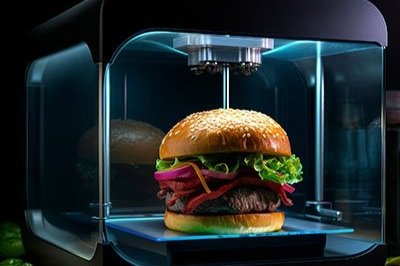The Ask
Make a prediction of a current or soon-to-happen innovation in technology, travel, leisure, health or wellness to forecast an upcoming trend.
The Process
The process to answering this question began with brainstorming ideas about the types of technology that people were prioritizing post-pandemic. This meant finding the '“zeitgeist,” also known as “the spirit of the time.” Post-
-
Following the pandemic, many consumers and industries became accustomed to convenience within the production process and workplace environment. The pandemic forced a reset that made people and businesses reevaluate industry and decision making processes. Businesses began to embrace technology in place of traditional labor because of the increased convenience.
-
The prediction was that 3D printing would become the widely accepted form of technology in manufacturing process within the next five years. 3D printing would be mass accepted among consumers because of its ability to aid various industries.
-
During the application process, our team identified specific industries certain to embrace 3D printing technologies. These sectors include food production, medicine, manufacturing and space exploration, as well as weaponry development.
Food Production
The rise of 3D printing in the food industry has led chefs, scientists, and food experts to explore imitation meat, particularly beef, fish, and chicken, in response to increasing demand for plant-based options driven by climate change concerns. Brands like Beyond Meat and Impossible Food Inc. have gained popularity, but achieving the exact taste and texture of traditional meat remains a challenge. Companies like Novameat, using a 3D printer and a mixture of pea protein, seaweed, and beetroot juice, aim to create a competitive plant-based alternative to steak. Founder Giuseppe Scionti believes they can match or even surpass the cost of traditional meat in the coming years. The exploration of 3D printed meat promises environmental benefits, including decreased greenhouse gas and nitrous oxide emissions, along with reductions in food waste.
Medicine
Each year due to the global organ shortage and limited organ donors, thousands of people are left needing organs in cases of severe injuries, illness or genetic conditions. Many of these people die before transplants are available to them. Tissue engineering has become an emerging field that works to produce artificial tissue and organ substitutes as permanent solutions to replace or repair damages. As biomedical engineers continue to further their research, they are working to develop 3D organ structures called scaffolds. The creation of scaffolds may help regenerate damaged tissues, which can be used in various tissue engineering applications. Nerve repair in structures constructed from biomaterials is a large target for biomedical engineers. The continuous development of customized 3D printed organs, including hearts and kidneys, from patients’ own cells is a process that is hopeful in reducing the likelihood of patients’ bodies rejecting them and speeds up the delivery of the organs to those who need them.
Manufacturing and Space
In the past several years NASA and other space agencies have begun to experiment with the use of 3D printing in production. 3D printing has many potential applications in the space industry and it set to become widely popular because of its ease and efficiency. NASA has been testing 3D printing methods in space to be able to create spare or replacement hardware aboard the International Space Station. This would increase the efficiency both on the ISS and for launches by limiting the amount of spare parts they have to send up and store. SpaceX also uses 3D printing to create space suits, the advantage being the pieces are easily replaceable since they can be made on a desktop 3D printer. Advancements in 3D printing enables production to be more streamlined and convenient.
The Outcome
The widespread acceptance of 3D printing in mainstream manufacturing and production processes is anticipated. Its potential applications in food production, medicine, manufacturing, space, and weapons highlight its versatility. Addressing issues such as food scarcity, some companies have already adopted 3D printing, while others plan to integrate it in the future. The appeal of technologically produced food and its efficient production make it applicable across various sectors.
In the realm of organ transplants, 3D printing has the potential to revolutionize waiting lists by overcoming barriers like blood type and scarcity. Tailoring organs to specific patients could significantly reduce mortality rates on transplant lists. In manufacturing, the use of 3D printers promises accelerated production, increased efficiency, and improved quality. Additionally, it ensures the safety of astronauts in space stations by facilitating the replacement of broken or missing parts.
However, the use of 3D printing in weapons production raises concerns, particularly with the emergence of untraceable firearms known as ghost guns. Access to a 3D printer now provides individuals with the means to create such weapons. Despite these challenges, the broad applications of 3D printing across industries suggest its potential success in the next five years.

